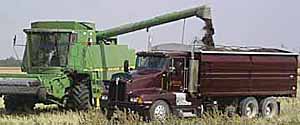Canadian Mennonite
Volume 10, No. 20
October 16, 2006

Camp Koinonia celebrates four decades of ministry
Boissevain, Man.
Whether you are three or 93, Camp Koinonia can steal your heart. Nestled in the Turtle Mountains at the edge of placid Max Lake, this place welcomed in full autumn splendour all who came to celebrate its 40th anniversary on Sept. 24, including Helena Dyck, just two months shy of her 93rd birthday.
“This place is holy because God of heaven has met people here,” said Karen Schellenberg, pastor of Portage Mennonite Church, as she led the worship service.
Camp Koinonia was dedicated on July 3, 1966. As part of the Boissevain community at that time, Jake Harms recalled the early visioning and dreaming. “Today we marvel, rejoice and celebrate with thanksgiving the grace of God,” he said. “Much has been realized, not without hassles or obstacles, but we can affirm that God has been active here…. It’s not heaven here, but it assuredly has brought people closer to heaven.”
Under a canopy of brilliantly coloured trees, guests enjoyed hot chili served from huge cauldrons.
Over lunch, Candace Stobbe, who had worked at Koinonia 37 years ago, met Linda Dyck, who had been a camper that same week. They recalled returning from evening worship at Koinonia Hill to the sight of the kitchen burning down.
“I remember we had turkey the next day,” said Stobbe. “I don’t remember if it was cooking while the kitchen burned.”
“I wasn’t really afraid,” remembered Dyck. “The adults were capably looking after things. My worst fear was that they might close the camp.”
Memory-sharing went late into the afternoon. Sometimes humorous, the stories reflected a sense of community.
Ed Franz remembered the time he canoed out to Birch Point with a group of campers for an overnight campout. The boys were instructed to find firewood for the evening meal. Next morning, Franz noticed that the birch tree that defined and gave the site its name was gone. Only a stump remained.
Some stories were evidence of the hard work and commitment that has helped to build this camp. George Engbrecht remembered making the 24-kilometre trip to camp with his posthole digger in January 1966. The biting cold as he drove his uncovered tractor and then digging the postholes was still vivid in his memory.
Werner Neufeld recalled that where nice gravel paths now meander, they had once tried digging three different wells to draw enough water for the camp.
A counsellor remembered one camp-out under the stars when the campers were discussing serious faith questions. “One girl in particular expressed doubts and wished for a sign from God when the sky burst into display of Northern Lights. The girl quietly whispered, ‘Okay, that was good enough for me.’”
Such were the memories evoked on this celebrative day. Camp Koinonia looks forward to continuing making memories.
Foodgrains crops harvested to feed people in need
Altona, Man.
 |
Manitoba farmers, supported by agri-businesses, community and church groups are nearing the completion of the harvest of crops they raised for the Canadian Foodgrains Bank this year, which uses the grain to meet the food needs of people in many countries. Community growing projects are a unique way for people to contribute grain and other agricultural commodities to help people who are hungry around the world.
In Manitoba, more than 3,200 acres were seeded with various crops on behalf of the foodgrains bank, with farmers enjoying generally good yields. About half the acres consisted of spring wheat, and the balance included winter wheat, canola, barley, soybeans, rye grass, oats, corn and alfalfa.
“It’s quite a change from last year in Manitoba, when many project acres could not be seeded,” says foodgrains bank resource coordinator Harold Penner, noting that this year hard spring wheat has gone as high as 175 bushels per hectare. “It’s wonderful to see the enthusiasm and smiling faces of farmers as the semi-trucks loaded with wheat or canola roll off the fields and head to the elevators.”
The Manitoba community projects vary in size from 16 to 200 hectares. The largest is the Arnaud-based Helping Other People Eat (HOPE) project. Growing projects include opportunities for Canadians to learn about food security issues and to develop a connection with overseas partners.
Last year, there were 133 growing projects in Ontario, 26 in Saskatchewan, 17 in Manitoba, 30 in Alberta and B.C., and six in Quebec and the Maritimes. Their gifts of grain and cash donated to the foodgrains bank totalled $6.8 million, supporting projects in 24 countries and benefiting more than five million people.